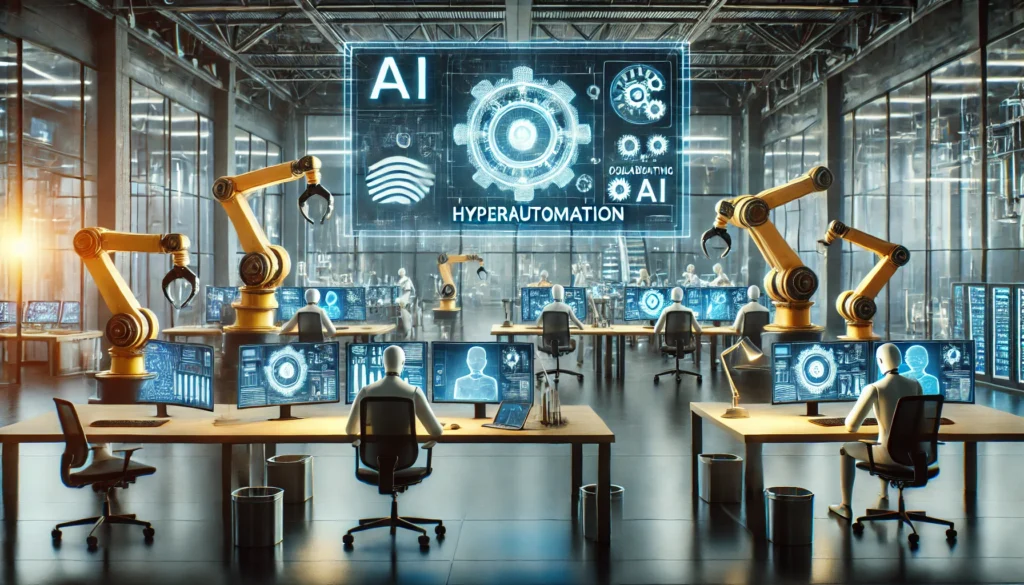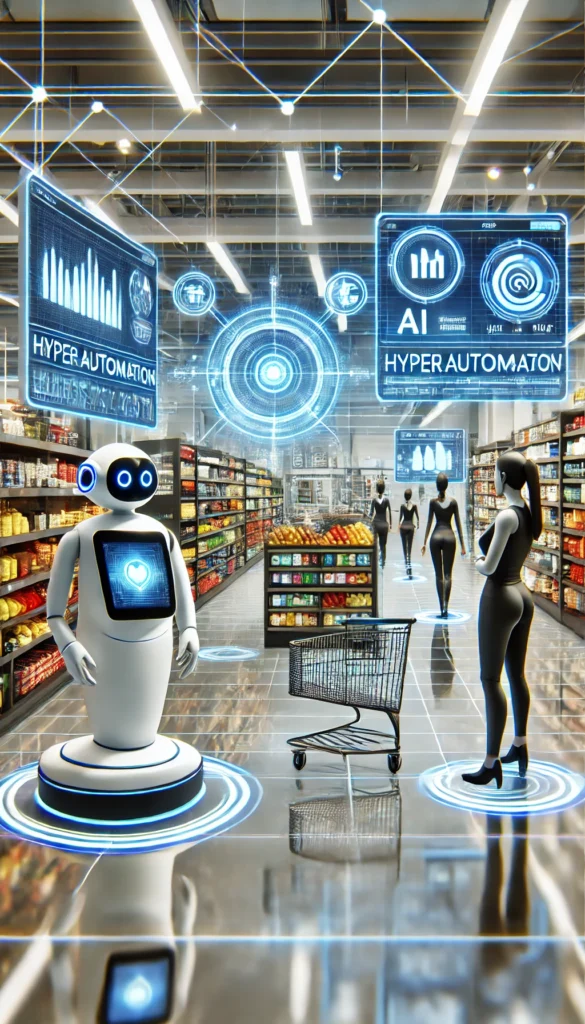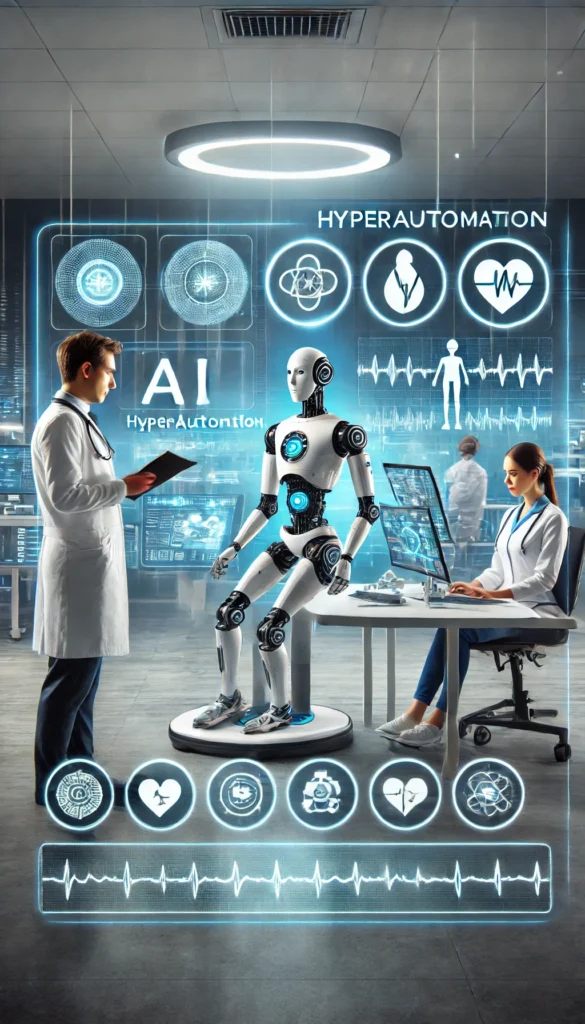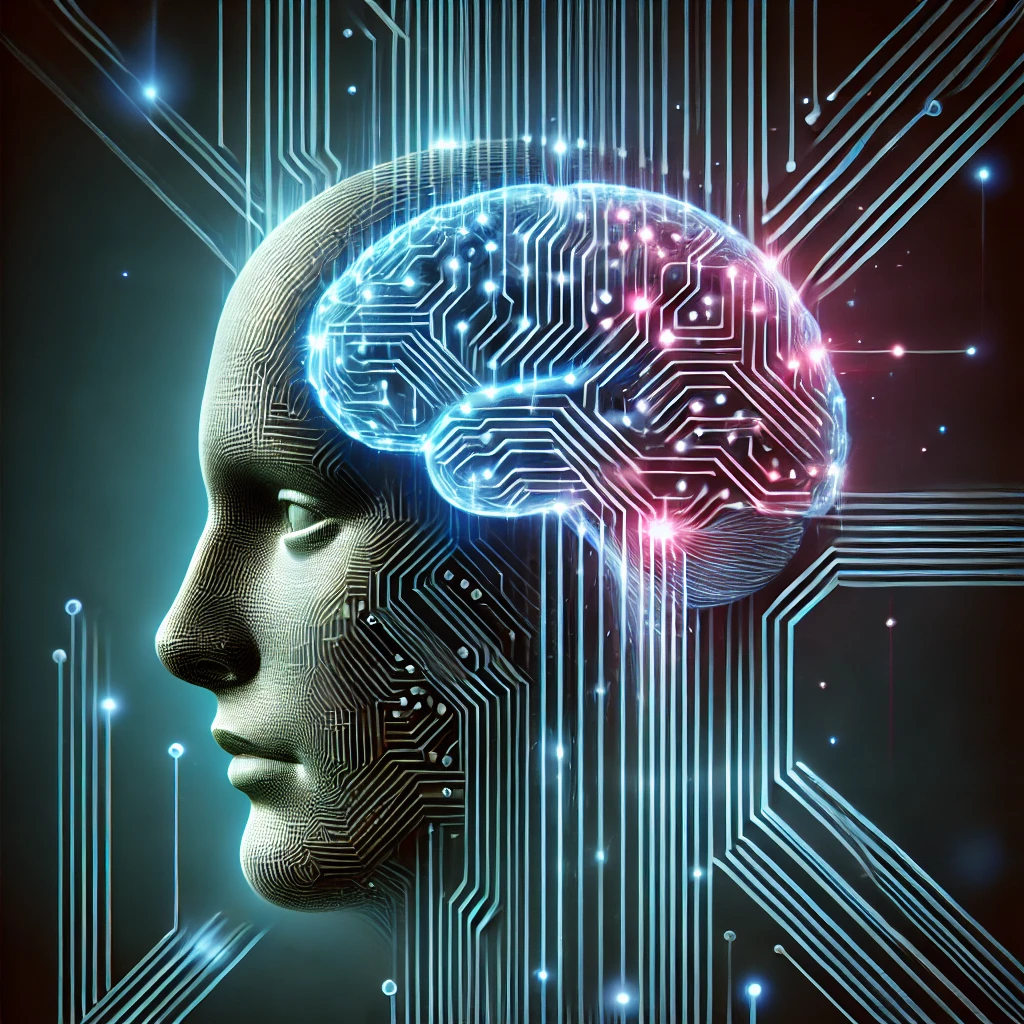Introduction
Imagine a world where businesses operate 24/7 without human intervention—where AI, bots, and software handle everything from data processing to customer interactions. Sounds futuristic? That future is already here, thanks to Hyperautomation.
Hyperautomation is transforming industries by integrating AI, machine learning, robotic process automation (RPA), and low-code tools. Companies are now automating complex workflows, reducing costs, and improving efficiency, making this one of the biggest tech revolutions of the decade.
But is Hyperautomation just a buzzword, or is it the key to the future of work? Let’s dive deep into its benefits, risks, and global impact.

What is Hyperautomation?
Hyperautomation is an advanced form of automation that goes beyond traditional RPA by incorporating AI, Natural Language Processing (NLP), process mining, and decision intelligence. Gartner defines Hyperautomation as a business-driven approach where companies automate as many processes as possible using advanced technologies.
Key Technologies Behind Hyperautomation:
- Artificial Intelligence (AI) & Machine Learning (ML): Enables systems to learn, adapt, and make data-driven decisions.
- Robotic Process Automation (RPA): Automates repetitive tasks like data entry, invoicing, and customer queries.
- Low-Code/No-Code Platforms: Allows businesses to create automation workflows with minimal coding.
- Intelligent Document Processing (IDP): Extracts and processes unstructured data from documents.
- Process Mining & Task Mining: Identifies inefficiencies and opportunities for automation.
Benefits of Hyperautomation
1. Increased Efficiency and Productivity
Hyperautomation reduces manual intervention in repetitive tasks, improving efficiency by up to 40%. AI-powered automation minimizes human errors, speeds up processes, and enhances accuracy.
2. Cost Savings & ROI Boost
Businesses that implement Hyperautomation report up to 30% cost reductions by eliminating redundant manual tasks, optimizing workflows, and reducing labor costs.
3. Enhanced Customer Experience
Chatbots, AI-driven analytics, and personalized automation improve response times and customer satisfaction. 75% of businesses adopting Hyperautomation see better customer engagement.
4. Improved Compliance & Security
Automated compliance tracking helps businesses adhere to regulations like GDPR and Data Protection Acts. AI-driven monitoring ensures security in finance, healthcare, and legal industries.
5. Scalability & Business Agility
Hyperautomation enables businesses to scale operations quickly without additional workforce investments. It also helps in adapting to market changes dynamically.

Industries Adopting Hyperautomation
Healthcare
- AI-driven patient data management and diagnostics.
- Automated billing and insurance processing.
- Real-time health monitoring with IoT-integrated automation.
Finance & Banking
- Fraud detection through AI-based anomaly tracking.
- Automated compliance reporting.
- Smart chatbots for customer service.
Retail & E-commerce
- AI-powered inventory and supply chain automation.
- Personalized marketing using customer behavior analysis.
- Automated order fulfillment and returns processing.
Manufacturing & Logistics
- Smart factories with IoT, AI, and robotics.
- Predictive maintenance using machine learning.
- Automated procurement and vendor management.


Challenges & Ethical Concerns
1. Job Displacement & Workforce Transformation
As automation replaces repetitive jobs, workforce reskilling is critical. Upskilling employees in AI, data science, and automation management is necessary to balance job losses.
2. Data Privacy & Security Risks
Hyperautomation relies on massive data collection. Regulations like GDPR and emerging data protection laws ensure privacy but require businesses to adopt strict security frameworks.
3. AI Bias & Ethical Considerations
Machine learning models can inherit biases, leading to unfair decision-making. Transparent AI frameworks and ethical AI guidelines must be in place.
Future Trends in Hyperautomation
1. AI-Driven Autonomous Agents
Future automation will involve self-learning AI agents that make decisions without human intervention. AI copilots in businesses will handle workflows independently.
2. Hyperautomation in Smart Cities
Urban planning and traffic management using AI-driven automation will enhance sustainability and reduce congestion in major metropolitan areas.
3. Blockchain & Hyperautomation Integration
Blockchain-powered smart contracts will automate transactions, compliance, and supply chain tracking securely and transparently.
How Businesses Can Prepare for Hyperautomation
- Invest in AI & Automation Training: Equip employees with automation skills.
- Adopt Cloud-Based Automation Solutions: Ensure scalability and remote accessibility.
- Monitor Compliance & Ethical AI Guidelines: Follow data protection laws and fairness standards.
- Partner with AI and Automation Experts: Collaborate with leading tech firms to implement automation.
FAQs
1. What is the difference between Automation and Hyperautomation?
Automation focuses on repetitive tasks, while Hyperautomation integrates AI, RPA, and analytics to automate complex processes end-to-end.
2. Can Hyperautomation replace human jobs?
While it can eliminate repetitive tasks, it also creates new opportunities for AI-driven job roles, upskilling, and process optimization.
3. Is Hyperautomation only for large enterprises?
No. SMEs are also adopting low-code automation tools to enhance efficiency at a smaller scale.
4. What are the best tools for Hyperautomation?
Popular tools include UiPath, Microsoft Power Automate, Automation Anywhere, and Google AutoML.
5. How secure is Hyperautomation?
Security depends on data governance frameworks and compliance measures like GDPR, DPDP Act, and AI ethics guidelines.
Conclusion
Hyperautomation is more than just a tech trend—it’s the future of intelligent business operations. From AI-driven decision-making to fully automated workflows, companies that embrace this revolution will gain a competitive edge.
What are your thoughts on Hyperautomation? Share in the comments!
References:
Ready to Stay Ahead? Bookmark our guide Technology and AI for updates!

